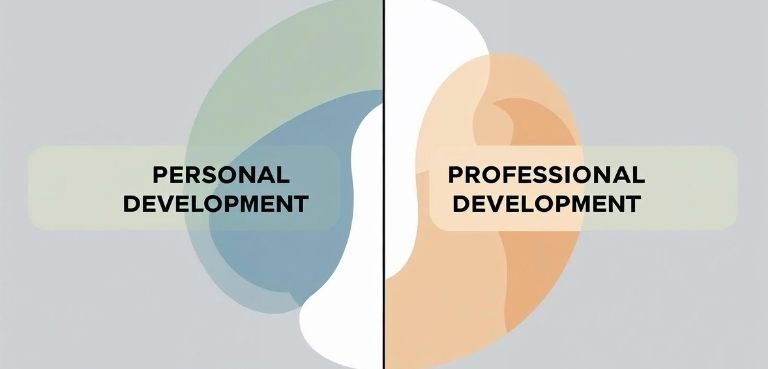No products in the basket.
If you want a fulfilling life and a strong career, you must master personal vs professional development and growth. The balance between the two shapes your skills, mindset, and future. In the UK, 79% of professionals say development opportunities make them more committed to their employer (CIPD, 2024). Yet many still don’t have a clear plan for both.
The truth? Focusing on only one type of growth leaves you with gaps. This guide will show you the differences, connections, and a practical plan to integrate both — backed by UK workplace data, proven frameworks, and real examples.
Quick Comparison Table
| Aspect | Personal Development | Professional Development |
| Scope | Life-wide growth, mindset, and habits | Career-specific skills and knowledge |
| Timeline | Lifelong | Role or industry-focused |
| Stakeholders | Self-led | Employers, industry bodies |
| Examples | Confidence building, resilience training | CPD courses, leadership certifications |
| Success Measures | Well-being, fulfilment | KPIs, promotions, qualifications |
Why you need both personal development and professional development
Imagine you’re technically brilliant but struggle to adapt under pressure — or you’re confident and resilient but lack up-to-date industry skills. Either gap limits your potential.
Personal growth strengthens emotional intelligence, resilience, and adaptability.
Professional growth develops technical ability, career mobility, and compliance.
Together, they make you future-proof.
Combine both personal and career development with our online personal development courses and CPD-accredited professional development courses at Training Tale.
What Is Personal Development?
Definition & Core Principles
Personal development is the ongoing process of improving your mindset, skills, and life satisfaction. It’s not just “self-help” — it’s about building capabilities that help you thrive inside and outside work.
UK-Ready Frameworks
Maslow’s hierarchy (for work)
Meet basic needs first — fair pay, safety, trust — before aiming for innovation or leadership. UK employees perform best when these foundations are met.
PERMA well-being model
Aim for: positive emotion, engagement, relationships, meaning, and achievement. A balanced plan hits all five.
Self-Determination Theory
Motivation thrives when you have autonomy, competence, and connection.
Key Focus Areas
- Emotional Intelligence (EQ)
- Resilience
- Relationships
- Well-being
- Purpose
Examples of Personal Development Goals
- Improve public speaking confidence
- Practise mindfulness daily
- Learn a new language
- Build a consistent exercise routine
- Develop better time management habits
What Is Professional Development?
Definition & Career Relevance
Professional development is the structured process of improving work-related skills and knowledge. It keeps you competent, competitive, and compliant — especially in regulated UK industries.
Types of Professional Development
- Hard Skills – technical abilities like coding, accounting, or data analysis
- Soft Skills – leadership, negotiation, and communication
- Continuous Professional Development (CPD) – formal, often regulated learning recognised by UK industry bodies
- Industry-Specific Training – qualifications or licences for your role
Understanding Continuous Professional Development (CPD)
CPD is mandatory in UK fields like healthcare, teaching, and law. It ensures your knowledge stays current.
70:20:10 with CPD (UK context)
- 70% on-the-job learning
- 20% mentoring and communities
- 10% formal CPD courses
- Record all three in your CPD log — UK regulators care about currency, not just classrooms.
Build your CPD hours flexibly with our accredited online professional development courses.
Examples of Professional Development Goals
- Complete a CPD-accredited leadership programme
- Gain a sector-specific certification
- Improve report-writing skills
- Attend an industry conference
- Build a professional network on LinkedIn

Professional Development vs Personal Development: Key Differences
Scope & Timeframes
Personal development is lifelong and wide-ranging. Professional development is more focused and deadline-driven.
Learning Methods
Personal growth often comes from self-directed activities. Professional growth may be employer-funded or tied to regulated CPD.
Stakeholders & Decision-Making
You lead personal growth. Employers, mentors, and industry bodies often drive professional growth.
Outcomes & Measurement
Personal growth is measured by confidence and life satisfaction. Professional growth is measured by KPIs, qualifications, and promotions.
How Personal and Professional Development Are Connected/Related
Personal and professional growth are not separate silos — they feed into each other every day. When you improve one, you often improve the other without realising.
Transferable Skills
Some skills work in every context. Strengthen them in your personal life and they will pay off in your career — and vice versa.
- Communication – Learning to express ideas clearly at work can improve how you resolve disagreements at home.
- Leadership – Managing a team project teaches delegation, which you can apply when organising community or volunteer work.
- Adaptability – Adjusting to a workplace restructure makes it easier to adapt to life changes.
- Problem-Solving – Tackling technical challenges at work sharpens your ability to handle unexpected personal issues.
- Time Management – Planning a complex work week can improve how you organise your personal commitments.
- Emotional Intelligence – Understanding colleagues’ emotions can also help you navigate personal relationships.
- Resilience – Coping with setbacks in either context builds a stronger, steadier mindset for the other.
Why Growth in One Accelerates the Other
If you gain confidence in personal areas, you are more willing to take risks and speak up professionally. These are the benefits of personal and professional development. When you upskill for work, you often feel more competent and capable in personal pursuits. This cycle means that investing in both areas speeds up your overall progress.
Mini Case Studies by Industry
Healthcare
A Band 5 nurse completes CPD on sepsis protocols while practising mindfulness. Handover errors drop, stress decreases, and patient care improves.
Tech
A software engineer learns a new cloud framework and runs creative problem-solving sessions. Deployment speed increases and incidents fall.
Education
A teacher earns a subject accreditation and trains in restorative conversations. Lesson quality improves, detentions drop, and parent relationships strengthen.
Benefits of Balancing Both
For Individuals
- Faster career growth
- Higher life satisfaction
- Stronger resilience
For Businesses
- Increased engagement
- Better retention
- Higher ROI on training
For Career Transitions
- Greater employability
- Mobility across industries
- Easier adaptation to change
Development by Career Stage
Early career
Build core habits first. Set one personal and one CPD goal each quarter. Focus on time management, communication, and confidence. Join a mentor circle and shadow colleagues.
Mid-career
Target stretch roles and recognised qualifications. Use the 70:20:10 model. Spend most time on live projects. Coach others to strengthen your own skills.
Senior / leadership
Scale yourself through people. Invest in strategic CPD. Tie CPD to business goals and measure outcomes, not just attendance. Publish your learning plan.
Myths vs Facts
Myth: You can only focus on one type of development at a time.
Fact: They can run in parallel and boost each other.
Myth: CPD is only classroom learning.
Fact: It includes mentoring, shadowing, and on-the-job training.
Myth: Professional development is just for promotions.
Fact: It’s essential for compliance, credibility, and adaptability.
How To Improve Personal and Professional Development: 7-Step Plan
Step 1 – Set SMART goals for each
Set clear personal and professional development goals each quarter to keep growth focused, measurable, and on track. Make sure your CPD targets are included if they apply to your role.
Step 2 – Map overlap between personal and professional skills
Look for skills that benefit both, such as leadership, time management, and communication. Developing these areas saves time and increases impact.
Step 3 – Allocate time blocks for each area
Book personal development time into your weekly schedule. Dedicate separate slots for professional learning, training, or CPD activities.
Step 4 – Use self-assessments
Regularly check your strengths and weaknesses. Use CPD self-assessment tools for career-specific skills and reflection journals for personal growth.
Step 5 – Seek mentors or coaches
Find guidance in both areas. A career mentor can help with CPD and technical skills, while a personal coach can support mindset and life goals.
Step 6 – Track progress with measurable and reflective metrics
Log training hours and CPD points. Also record personal achievements, such as improved habits or milestones reached.
Step 7 – Adjust your plan quarterly
Revisit your goals and progress. Update your CPD record, adapt to changes in your career, and refine your personal priorities.
Self-Assessment Toolkit
Personal Growth Checklist
- Improved stress management?
- Strengthened a relationship?
- Tried something new?
Professional Development Tracker
- CPD hours completed
- Skills gained
- Qualifications earned
- New connections made
Common Challenges (and How to Overcome Them)
Time Constraints – Block time like a meeting.
Lack of Clear Goals – Set specific objectives.
Motivation Drops – Track wins and celebrate small successes.
External Pressures – Adapt goals rather than pausing progress.
FAQs About Personal vs Professional Development and Growth
1. Is personal or professional development more important?
- Both are essential — they support different aspects of your growth.
2. Can one replace the other?
- No. Neglecting one limits your potential.
3. How often should I update my plan?
- Quarterly works best for most people.
4. Best tools for tracking growth?
- CPD logs, learning journals, and goal-tracking apps.
Final Thoughts: Commit to Continuous Growth
Balancing personal vs professional development and growth creates a stronger, more adaptable you. Start small — one personal and one professional goal each week.





